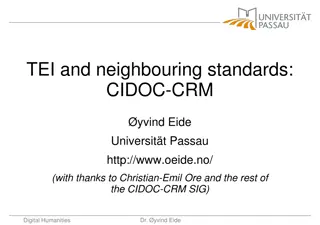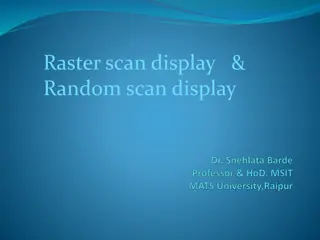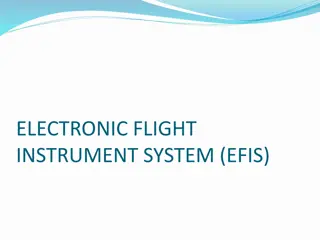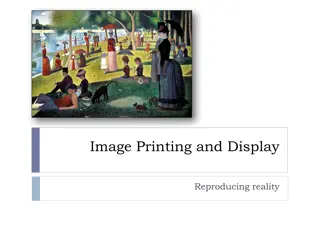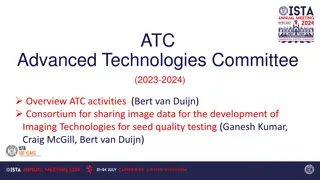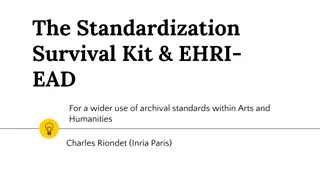Exploring Display Technologies: A Course Overview at TEI of Crete
Delve into the fascinating world of display technologies with a comprehensive course offered to Erasmus students and beyond at the Department of Electronics Engineering, TEI of Crete. This course, led by Prof. Yiannis Kaliakatsos, covers a range of topics such as luminescence phenomena, cathode ray tubes, LED displays, plasma physics, liquid crystal displays, OLED displays, and more. Discover the principles behind luminescence, its applications in various fields, and its significance in modern technology.
Download Presentation

Please find below an Image/Link to download the presentation.
The content on the website is provided AS IS for your information and personal use only. It may not be sold, licensed, or shared on other websites without obtaining consent from the author. Download presentation by click this link. If you encounter any issues during the download, it is possible that the publisher has removed the file from their server.
E N D
Presentation Transcript
Display Technologies A course for Erasmus Students and not only in Dept. of Electronics Engineering, TEI of Crete A series of transparencies for the lectures given by Prof. Yiannis Kaliakatsos TEI of Crete
Table of Contents Luminescence phenomena Cathode ray tubes TV Operation Electroluminescence Light Emitting Diodes (LEDs) LED Displays Electroluminescent Displays Electronic paper displays Plasma Physics Basic Plasma Displays Liquid Crystals Basic Liquid Crystal Displays TFT Dispays OLED Displays OLED Displays Complimentary Lecture
Luminescence phenomena Definition1 Luminescence is emission of light by a substance not resulting from heat; it is thus a form of cold body radiation. It can be caused by chemical reactions, electrical energy, subatomic motions, or stress on a crystal. This distinguishes luminescence from incandescence, which is light emitted by a substance as a result of heating. The term 'luminescence' was introduced in 1888 by Eilhard Wiedemann 1. https://en.wikipedia.org/wiki/Luminescence
Luminescence phenomena Fireflies have a bioluminescent organ in their abdomen that they use to attract mates. Chemicals within the organ react with oxygen to produce light. The insect controls the flashes by regulating the flow of oxygen. (Reproduced by permission of The Stock Market Read more: http://www.scienceclarified.com/Io- Ma/Luminescence.html#ixzz5h8e1cYEB Squid, shrimp, sardines, plankton, starfish, and all kinds of other marine creatures use bioluminescence for communication, camouflage, or defense flashing to attract mates or warn off predators.
Luminescence phenomena "Luminous" (phosphorescent) paints, energy-saving fluorescent lamps, and fluorescent (high-visibility) jackets are obvious examples.
Luminescence phenomena There are many other applications of luminescence. Old-style, cathode-ray television sets (and oscilloscopes) make pictures by firing electron guns at a screen coated with phosphors (phosphorescent chemicals). Lasers make their powerful beams by a process called stimulated emission, which happens when atoms are forced to give off photons over and over again. UV lights are used to produce phosphorescence in a variety of medical tests, in archaeological research, and in forensic science to aid the detection of crime.
Luminescence phenomena Some uses of luminescence are even more surprising. Many washing detergents contain ingredients known as optical brighteners, which are actually phosphorescent chemicals. When sunlight falls on recently washed clothes, atoms of the optical- brightener chemicals, left behind by the detergents, become excited and convert the sun's ultraviolet light into ordinary light. As a result, when you look at freshly washed white clothes, you're supposed to see brighter, slightly bluer reflected light produced by the optical brighteners. The idea is that your clothes look cleaner and brighter, which is why TV commercials used to talk about "bluey whiteness" and featured smiling people holding their clothes up to a window (where there's more UV-rich sunlight) to see it. It's amazing some of the places where you find science even lurking in your laundry!
The following are types of luminescence: Electroluminescence, a result of an electric current passed through a substance Cathodoluminescence, a result of a luminescent material being struck by the electrons Photoluminescence, a result of absorption of photons Fluorescence, photoluminescence as a result of singlet singlet electronic relaxation (typical lifetime: nanoseconds) Phosphorescence, photoluminescence as a result of triplet singlet electronic relaxation (typical lifetime: milliseconds to hours) Radioluminescence, a result of bombardment by ionizing radiation
Other types of luminescence Chemiluminescence, a result of a chemical reaction Bioluminescence, emission as a result of biochemical reaction by a living organism Electrochemiluminescence, a result of an electrochemical reaction Crystalloluminescence, produced during crystallization Thermoluminescence, the re-emission of absorbed energy when a substance is heated[4] Cryoluminescence, the emission of light when an object is cooled (an example of this is wulfenite)[citation needed] Mechanoluminescence, a result of a mechanical action on a solid Triboluminescence, generated when bonds in a material are broken when that material is scratched, crushed, or rubbed Fractoluminescence, generated when bonds in certain crystals are broken by fractures Piezoluminescence, produced by the action of pressure on certain solids[3] Sonoluminescence, a result of imploding bubbles in a liquid when excited by sound
Luminescence principle Luminescence is a process where a substance emits light as an effect of the absorption of energy in various forms. This leads to a shift of electrons to a higher energy level. But this high energy situation is very unstable, which is why electrons tend to return to their ground state. During this procedure energy is released again in the form of photons that can be seen as a glow. We have two types of luminescence according to the relaxation time before light emission
In fluorescence, electron energy conversion is very fast, in fact in the range of nanoseconds. Any substance which can emit light of a distinct wavelength after excitation is called a phosphor. phosphorescence is a light-emitting phenomenon where the phosphorescent material is excited by a type of energy. Even though it is closely related to fluorescence, it is much slower. In contrast to fluorescence the re-emission of photons is decelerated by the association of excited electrons energy with a "forbidden" state.
Simplified Jablonski Diagram of Luminescence phenomenon From: https://en.wikipedia.org/wiki/Phosphorescence Their return to the ground state does not occur as fast as in the case of fluorescence because energy is "trapped". Typical examples of phosphorescent materials are "glow-in-the- dark" toys which can be charged with an ordinary light bulb or daylight and then emit light for several minutes or even hours.
Theory of Luminescence The luminescence phenomenon is explained by solid-state band theory. A solid material can be visualized as having a valence band and a conduction band with an intervening band gap (forbidden gap).
If a crystal is exciting by sufficient energy, electrons from the lower-energy valence band are promoted to the higher-energy conduction band. When the energetic electrons attempt to return to the ground state valence band, they may be temporarily trapped (on the scale of microseconds) by intrinsic (structural defects) and/or extrinsic (impurities) traps. If the energy lost when the electrons vacate the traps is emitted is in the appropriate energy/wavelength range, luminescence will result.
There are several possible ways in which the traps can interact to produce luminescence (Fig.). Once the electrons are excited to the conduction band, they may not encounter a trap and fall to the valence band or they move randomly through the crystal structure until a trap is encountered. From that trap, the electron might return to the ground state or it may encounter multiple traps emitting photons with wavelengths dependent on the energy differences. The intensity of the CL is generally a function of the density of the traps.
Intrinsic luminescence is characteristic of the host lattice. It can be due to non-stoichiometry (vacancies), structural imperfections (poor ordering in the crystal, radiation damage, shock damage, etc.) and impurities (non-activators that distort the lattice). Extrinsic luminescence results from impurities in the structure. The impurities generate luminescent centers and are most commonly transition elements, rare earth elements and actinide elements (due to the occurrence of valence electrons in either "d" or "f" orbitals, see below). These impurities are generally the most common source of luminescence in minerals. There are several categories of interactions that influence the character of the luminescence.
Activators these are trace elements (substitutional) that promote luminescence in a material. In general, luminescence intensity will increase with concentration to a point. With further increase in concentration, it will decrease (i.e. self- quench) dependent on the structure of the lattice. Examples of important activators in phosphors include Mn2+, Cr3+, Fe3+, Ti4+and rare earth elements (REEs). A further consideration is that the intensity and wavelength of the luminescence is dependent on the electron configuration of the activator ion and the nature of the lattice that holds the ion.
In some materials the luminescence is dependent primarily on the type of REE because the CL commonly involves shielded 4f and 5f orbitals and does not have much influence from bonds with nearby atoms. For activators such as the first-row transition elements the 3d electronic levels are sensitive to the site geometry. For the example of Mn2+in various carbonate materials, the influence of the local bonding environment and site geometry has a significant effect on the luminescence response (Fig. 2).
Sensitizers (co-activators)these are ions that must coexist with another activator, absorb energy, re-emit it to an activator and enhance the luminescence response of the activator. For example, Pb2+can serve as a sensitizer for Mn2+located in calcite. Quenchers there are ions that inhibit or eliminate luminescence in a material. The most important quencher in minerals is typically Fe2+, but Co2+, Ni2+and Fe3+are also known to act as quenchers.
Luminescence Spectra - Numerous activators may be present in a material and can generate a complex spectrum in the visible light region. Luminescence instruments equipped with a monochrometer (or spectrophotometer) can resolve the luminescence signal for multiple peaks. By placing a focused electron beam on an area of interest such as a highly luminescent zone in a mineral, it is possible to determine the wavelength(s) that contribute to areas of anomalous luminescence; these wavelengths are commonly interpreted as being derived from a specific element in a given valence state.
Conversely, the monochrometer can be tuned to a single or limited range of wavelengths, and you can then obtain a map of all areas that have the same luminescence; this can then be interpreted as a map of the distribution of a given activator element. Because the luminescence signal is sensitive to the chemical state of polyvalent elements (e.g. Mn+2v. Mn+3), it is possible to do chemical mapping (in addition to compositional mapping) of redox reactions by showing the distribution of relatively oxidized or reduced domains in a sample.
Dependence of photoluminescence spectrum from the activators
Dependence of photoluminescence spectrum from dopant concentration
Dependence of photoluminescence spectrum from activator concentration



